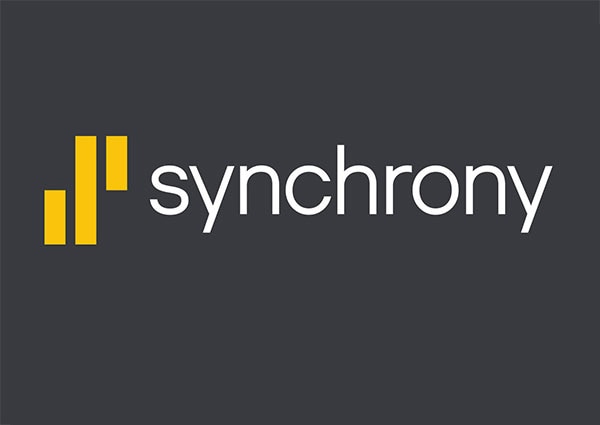Press Release
January 24, 2020, 6:05 AM EST
Synchrony Financial Reports Fourth Quarter Net Earnings of $731 Million or $1.15 Per Diluted Share
Includes Benefit from Walmart Portfolio Reserve Reduction of $0.05 Per Diluted Share
STAMFORD, Conn. – Synchrony Financial (NYSE: SYF) today announced fourth quarter 2019 net earnings of $731 million, or $1.15 per diluted share; this includes a $38 million pre-tax, $28 million after-tax, or $0.05 per diluted share benefit from a reduction in the reserve related to the sale of the Walmart consumer portfolio, which was completed in October. Highlights included*.
- Loan receivables decreased 6% to $87.2 billion; loan receivables grew 5% on a Core** basis
- Interest and fees on loans decreased 6% to $4.5 billion; interest and fees on loans increased 5% on a Core basis
- Purchase volume was flat at $40.2 billion; purchase volume was up 7% on a Core basis
- Average active accounts decreased 5% to 74 million; average active accounts grew 3% on a Core basis
- Deposits grew $1.1 billion, or 2%, to $65.1 billion
- Announced a new partnership with Verizon making Synchrony the exclusive issuer of Verizon’s co-branded consumer credit card which will be launched in the first half of this year
- Established new Payment Solutions relationships: Mor Furniture for Less, Grand Home Furnishings, Travis Industries, and Leisure Pro
- Renewed key Payment Solutions relationships: Rooms To Go, BuyMax Alliance, CFMOTO, and Continental Tires
- CareCredit established a new relationship with Kaiser Permanente, bringing the number of health systems under contract to five, and renewed a key relationship with Demant
- Paid quarterly common stock dividend of $0.22 per share and repurchased $1.4 billion of Synchrony Financial common stock
- Issued $750 million of preferred stock
“2019 marked another year of significant transformation for Synchrony. During the year we renewed over 50 partnerships and won 30 new business deals, expanded our CareCredit, Auto and Home networks, significantly enhanced the digital experience for our cardholders, and substantially grew our direct-to-consumer deposit platform. The consistent investments we have made in people and technology have propelled our company forward and empowered leading offerings for our partners and enhanced capabilities and user experiences for our cardholders. Organic growth continues to present the largest opportunity as we have demonstrated in our ability to not only grow existing programs, but also launch new programs with fast-growing partners in new markets,” said Margaret Keane, Chief Executive Officer of Synchrony Financial. “Further, we remain focused on executing a capital allocation strategy that helps to drive growth at attractive risk adjusted returns, while maintaining a strong balance sheet and the ability to continue to return capital to shareholders.”
Business and Financial Highlights for the Fourth Quarter of 2019*
Earnings
- Net interest income decreased $304 million, or 7%, to $4.0 billion, with the impact from the sale of the Walmart consumer portfolio offsetting loan receivables growth.
- Retailer share arrangements increased $174 million, or 20%, to $1.0 billion, mainly driven by improved program performance and growth in loan receivables.
- Provision for loan losses decreased $348 million, or 24%, to $1.1 billion, largely driven by a lower core reserve build and a reduction in net charge-offs.
- Other income increased $40 million, or 63%, to $104 million, largely driven by lower loyalty program costs as a result of the sale of the Walmart consumer portfolio.
- Other expense remained flat at $1.1 billion and included a restructuring charge of $21 million included in employee costs.
- Net earnings totaled $731 million compared to $783 million last year.
Balance Sheet
- Period-end loan receivables decreased 6%; On a Core basis, loan receivables increased 5%, purchase volume growth was 7%, and average active accounts increased 3%.
- Deposits grew to $65.1 billion, up $1.1 billion, or 2%, and comprised 77% of funding.
- The Company’s balance sheet remained strong with total liquidity (liquid assets and undrawn credit facilities) of $23.4 billion, or 22.3% of total assets.
- The estimated fully phased-in Common Equity Tier 1 ratio under Basel III was 14.1%, compared to 14.0%, reflecting the Company’s strong capital generation capabilities while deploying capital through organic growth, program acquisitions, and continued execution of our capital plans.
Key Financial Metrics
- Return on assets was 2.7% and return on equity was 19.0%.
- Net interest margin was 15.01%.
- Efficiency ratio was 34.8%.
Credit Quality
- Loans 30+ days past due as a percentage of total period-end loan receivables were 4.44% compared to 4.76% last year; excluding the PayPal Credit program and the Walmart portfolio, the rate was flat compared to last year.
- Net charge-offs as a percentage of total average loan receivables were 5.15% compared to 5.54% last year; excluding the PayPal Credit program and the Walmart portfolio, the rate decreased approximately 15 basis points compared to last year.
- The allowance for loan losses as a percentage of total period-end loan receivables was 6.42% compared to 6.90% last year.
Sales Platforms
- Retail Card period-end loan receivables decreased 12%; period-end loan receivables increased 4% on a Core basis primarily driven by digital partners. Interest and fees on loans decreased 10%, purchase volume decreased 2%, and average active accounts decreased 7%, primarily driven by the sale of the Walmart consumer portfolio.
- Payment Solutions period-end loan receivables grew 4%, which included the impact of the reclassification of the Yamaha portfolio to loan receivables held for sale; period-end loan receivables increased 7% on a Core basis led by home furnishings and home specialty. Interest and fees on loans increased 4%, primarily driven by the loan receivables growth. Purchase volume growth was 6% and average active accounts increased 3%.
- CareCredit period-end loan receivables grew 8%, led by dental and veterinary. Interest and fees on loans increased 9%, primarily driven by the loan receivables growth. Purchase volume growth was 12% and average active accounts increased 5%.
* All comparisons are for the fourth quarter of 2019 compared to the fourth quarter of 2018, unless otherwise noted.
**Financial measures shown above on a Core basis are non-GAAP measures and exclude from both the prior year and the current year amounts related to the Walmart and Yamaha portfolios, sold in October 2019 and January 2020, respectively. See non-GAAP reconciliation in the financial tables.
Corresponding Financial Tables and Information
No representation is made that the information in this news release is complete. Investors are encouraged to review the foregoing summary and discussion of Synchrony Financial's earnings and financial condition in conjunction with the detailed financial tables and information that follow and the Company's Annual Report on Form 10-K for the fiscal year ended December 31, 2018, as filed February 15, 2019, and the Company's forthcoming Annual Report on Form 10-K for the year ended December 31, 2019. The detailed financial tables and other information are also available on the Investor Relations page of the Company's website at www.investors.synchronyfinancial.com. This information is also furnished in a Current Report on Form 8-K filed with the SEC today.
Conference Call and Webcast Information
On Friday, January 24, 2020, at 7:30 a.m. Eastern Time, Margaret Keane, Chief Executive Officer, Brian Doubles, President, and Brian Wenzel, Executive Vice President and Chief Financial Officer, will host a conference call to review the financial results and outlook for certain business drivers. The conference call can be accessed via an audio webcast through the Investor Relations page on the Synchrony Financial corporate website, www.investors.synchronyfinancial.com, under Events and Presentations. A replay will be available on the website or by dialing (888) 843-7419 (U.S. domestic) or (630) 652-3042 (international), passcode 42019#, and can be accessed beginning approximately two hours after the event through February 7, 2020.
About Synchrony Financial
Synchrony (NYSE: SYF) is a premier consumer financial services company. We deliver a wide range of specialized financing programs, as well as innovative consumer banking products, across key industries including digital, retail, home, auto, travel, health and pet. Synchrony enables our partners to grow sales and loyalty with consumers. We are one of the largest issuers of private label credit cards in the United States; we also offer co-branded products, installment loans and consumer financing products for small- and medium-sized businesses, as well as healthcare providers.
Synchrony is changing what’s possible through our digital capabilities, deep industry expertise, actionable data insights, frictionless customer experience and customized financing solutions.
For more information, visit www.synchrony.com and Twitter: @Synchrony.
Cautionary Statement Regarding Forward-Looking Statements
This news release contains certain forward-looking statements as defined in Section 27A of the Securities Act of 1933, as amended, and Section 21E of the Securities Exchange Act of 1934, as amended, which are subject to the "safe harbor" created by those sections. Forward-looking statements may be identified by words such as "expects," "intends," "anticipates," "plans," "believes," "seeks," "targets," "outlook," "estimates," "will," "should," "may" or words of similar meaning, but these words are not the exclusive means of identifying forward-looking statements. Forward-looking statements are based on management's current expectations and assumptions, and are subject to inherent uncertainties, risks and changes in circumstances that are difficult to predict. As a result, actual results could differ materially from those indicated in these forward-looking statements. Factors that could cause actual results to differ materially include global political, economic, business, competitive, market, regulatory and other factors and risks, such as: the impact of macroeconomic conditions and whether industry trends we have identified develop as anticipated; retaining existing partners and attracting new partners, concentration of our revenue in a small number of Retail Card partners, promotion and support of our products by our partners, and financial performance of our partners; cyber-attacks or other security breaches; higher borrowing costs and adverse financial market conditions impacting our funding and liquidity, and any reduction in our credit ratings; our ability to grow our deposits in the future; our ability to securitize our loan receivables, occurrence of an early amortization of our securitization facilities, loss of the right to service or subservice our securitized loan receivables, and lower payment rates on our securitized loan receivables; changes in market interest rates and the impact of any margin compression; effectiveness of our risk management processes and procedures, reliance on models which may be inaccurate or misinterpreted, our ability to manage our credit risk, the sufficiency of our allowance for loan losses and the accuracy of the assumptions or estimates used in preparing our financial statements; our ability to offset increases in our costs in retailer share arrangements; competition in the consumer finance industry; our concentration in the U.S. consumer credit market; our ability to successfully develop and commercialize new or enhanced products and services; our ability to realize the value of acquisitions and strategic investments; reductions in interchange fees; fraudulent activity; failure of third parties to provide various services that are important to our operations; disruptions in the operations of our computer systems and data centers; international risks and compliance and regulatory risks and costs associated with international operations; alleged infringement of intellectual property rights of others and our ability to protect our intellectual property; litigation and regulatory actions; damage to our reputation; our ability to attract, retain and motivate key officers and employees; tax legislation initiatives or challenges to our tax positions and/or interpretations, and state sales tax rules and regulations; a material indemnification obligation to GE under the tax sharing and separation agreement with GE if we cause the split-off from GE or certain preliminary transactions to fail to qualify for tax-free treatment or in the case of certain significant transfers of our stock following the split-off; regulation, supervision, examination and enforcement of our business by governmental authorities, the impact of the Dodd-Frank Wall Street Reform and Consumer Protection Act and other legislative and regulatory developments and the impact of the Consumer Financial Protection Bureau's regulation of our business; impact of capital adequacy rules and liquidity requirements; restrictions that limit our ability to pay dividends and repurchase our common stock, and restrictions that limit Synchrony Bank's ability to pay dividends to us; regulations relating to privacy, information security and data protection; use of third-party vendors and ongoing third-party business relationships; and failure to comply with anti-money laundering and anti-terrorism financing laws.
For the reasons described above, we caution you against relying on any forward-looking statements, which should also be read in conjunction with the other cautionary statements that are included elsewhere in this news release and in our public filings, including under the heading "Risk Factors" in the Company's Annual Report on Form 10-K for the fiscal year ended December 31, 2018, as filed on February 15, 2019. You should not consider any list of such factors to be an exhaustive statement of all the risks, uncertainties, or potentially inaccurate assumptions that could cause our current expectations or beliefs to change. Further, any forward-looking statement speaks only as of the date on which it is made, and we undertake no obligation to update or revise any forward-looking statement to reflect events or circumstances after the date on which the statement is made or to reflect the occurrence of unanticipated events, except as otherwise may be required by law.
Non-GAAP Measures
The information provided herein includes measures we refer to as "tangible common equity" and certain “Core” financial measures that have been adjusted to exclude amounts related to the Walmart and Yamaha portfolios, sold in October 2019 and January 2020, respectively, which are not prepared in accordance with U.S. generally accepted accounting principles ("GAAP"). For a reconciliation of these non-GAAP measures to the most directly comparable GAAP measures, please see the detailed financial tables and information that follow. For a statement regarding the usefulness of these measures to investors, please see the Company's Current Report on Form 8-K filed with the SEC today.











